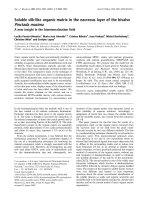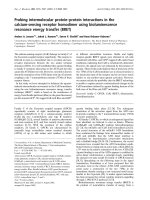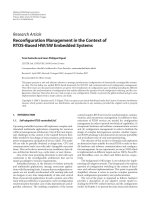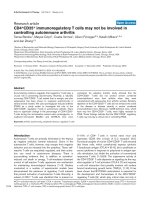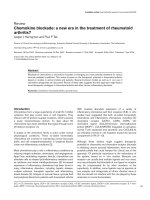Báo cáo y học: "Nature of Regulatory T Cells in the Context of Allergic Disease." ppsx
Bạn đang xem bản rút gọn của tài liệu. Xem và tải ngay bản đầy đủ của tài liệu tại đây (206.04 KB, 5 trang )
ORIGINAL ARTICLE
Nature of Regulatory T Cells in the Context of Allergic
Disease
Cevdet Ozdemir, MD, Mu
¨
beccel Akdis, MD, PhD, and Cezmi A. Akdis, MD
Allergen-specific immunotherapy (SIT) is the cornerstone of the management of allergic diseases, which targets modification of the
immunologic response, along with environmental allergen avoidance and pharmacotherapy. SIT is associated with improved
tolerance to allergen challenge, with a decrease in immediate-phase and late-phase allergic inflammation. SIT has the potential to
prevent development of new sensitizations and progression of allergic rhinitis to asthma. It has a role in cellular and humoral
responses in a modified pattern. The ratio of T helper (Th)1 cytokines to Th2 cytokines is increased following SIT, and functional
regulatory T cells are induced. Interleukin-10 production by monocytes, macrophages, and B and T cells is increased, as well as
expression of transforming growth factor b. SIT is associated with increases in allergen-specific antibodies in IgA, IgG1, and IgG4
isotypes. These blocking-type immunoglobulins, particularly IgG4, may compete with IgE binding to allergen, decreasing the
allergen presentation with the high- and low-affinity receptors for IgE (FceRI and FceRII, respectively). Additionally, SIT reduces the
number of mast cells and eosinophils in the target tissues and release of mediators from these cells.
Key words: dendritic cells, mucosal tolerance, regulatory T cells, allergen-specific immunotherapy
T
he allergic immune response is directed against
various environmental allergens and manifests clini-
cally as allergic rhinitis, allergic asthma, food allergy,
allergic skin inflammation, ocular allergy, and/or anaphy-
laxis. Contact of an allergen with the immune system starts
with handling of it by the antigen-presenting cells, mainly
dendritic cells (DCs), which process antigenic material and
present it on its surface to other cells of the immune
system, especially to CD4
+
T helper (Th)2 cells. This
results in Th2-type cytokine production (interleukin [IL]-
4, IL-13), which causes class switching of B cells for
production of IgE. Allergen-specific IgE antibodies bind to
high-affinity FceRI receptors that are expressed on mast
cells and basophils. On reexposure to the same offending
allergen, interaction of allergen with allergen-specific IgE
results in degranulation of preformed granules in mast
cells. In addition to the release of histamine and proteases,
the synthesis and release of newly generated lipid-derived
mediators, such as leukotrienes and cytokines, responsible
for the symptoms and signs of allergic disorders occur.
1–3
The late-phase response appears during the 6- to 12-hour
period after allergen exposure and is a cell-driven process
with infiltration of eosinophils, neutrophils, basophils, T
lymphocytes, and macrophages, which release additional
inflammatory mediators and cytokines, perpetuating the
proinflammatory response. This late-phase response is
thought to be responsible for the persistent, chronic signs
and symptoms of allergic diseases. Continued allergen
exposure often establishes a state of chronic symptomatic
inflammation.
4,5
Treatment strategies such as antihistamines, antileuko-
trienes, b
2
-adrenergic receptor agonists, and corticoster-
oids aiming at suppression of mediators and immune cells
can be used to control the symptoms and progression of
allergic diseases; however, cessation of these treatments
may eventually lead to the relapse of the disease.
6
Allergen-
specific immunotherapy (SIT) represents the only curative
and unique method of treatment for allergic disorders,
specifically restoring normal immunity against previously
disease-causing allergens and therefore offering a long-
lasting solution.
6–14
Cevdet Ozdemir: Division of Pediatric Allergy and Immunology,
Istanbul, Turkey; Mu
¨
beccel Akdis and Cezmi A. Akdis: Swiss Institute
of Allergy and Asthma Research, Davos, Switzerland.
The authors’ laboratory is funded by the Swiss National Science
Foundation (grants no. SNF-32-112306/1, 32-118226) and the Global
Allergy and Asthma European Network.
Correspondence to: Cezmi A. Akdis, MD, Swiss Institute of Allergy and
Asthma Research, Obere Strasse 22, CH-7270 Davos, Switzerland; e-
mail:
DOI 10.2310/7480.2008.00015
106 Allergy, Asthma, and Clinical Immunology, Vol 4, No 3 (Fall), 2008: pp 106–110
The mechanisms by which SIT has its effects include
the very early desensitization effect. The regulation of T-
cell responses by generation of T regulatory (Treg) cells
induces peripheral T-cell tolerance. Modulation of B-cell
interactions results in alterations in allergen-specific IgE
and IgG subtype synthesis. Also, suppression of effector
cells (eosinophils, basophils, and mast cells) and their
inflammatory responses occurs (Figure 1).
1,3,6,15–18
For an
efficient immunotherapy course, well-standardized native
proteins or recombinant allergens should be used to
induce tolerance in allergen-specific T cells. For accurate
results, SIT is expected to suppress IgE production and
type I skin test reactivity in accordance with promot-
ing IgG4 and IgA types of antibody production that
can block the responsiveness of IgE for allergens. For a safe
and efficient SIT, it is a requisite to develop routes with
ease of applicability that will have persistent clinical
effectiveness that can be built within a short duration of
therapy time.
1
Early and Late Effects of SIT on Mast Cells,
Basophils, and Eosinophils
SIT has early and late impacts on major cells of allergic
inflammation. Rapid clinical tolerance induction can be
seen in rush and ultrarush bee venom immunotherapy
(VIT) protocols over several hours, which supports the
effect of SIT on early desensitization. It has been
demonstrated that an absolute amount of histamine
released in response to stimulation was decreased after
major bee venom allergen stimulations. Moreover, a
significant reduction in leukotriene C4 production after
VIT in samples stimulated with that specific allergen was
reported.
19
Additionally, suppression of basophil IL-4 and
IL-13 during early phases of rush immunotherapy has been
demonstrated.
20,21
SIT modifies the number and the function of effector
cells that mediate the allergic response.
3,22
For example,
the numbers of Th2 cells and eosinophils are reduced at
Figure 1. Allergen-specific immunotherapy (SIT) is associated with improved tolerance to allergen challenge, with a decrease in immediate-phase
and late-phase allergic inflammation. SIT also reduces the number of effector cells and release of their mediators in the target tissues. It has a role in
cellular and humoral responses. T helper (Th)2 cytokines are decreased, and functional regulatory T cells (Tregs) are induced. Interleukin (IL)-10
production by monocytes, macrophages, B cells, and T cells is increased, as well as expression of transforming growth factor b (TGF-b). SIT is
associated with increases in allergen-specific antibodies in IgA, IgG1, and IgG4 isotypes. SIT also prevents development of new sensitizations and
progression of allergic rhinitis to asthma.
Ozdemir et al, Regulatory T Cells in the Context of Allergic Disease 107
sites of allergen challenge following SIT.
23,24
Furthermore,
SIT reduces the seasonal increases in the number of
basophils and eosinophils
25,26
in the mucosa, as well as the
number of mast cells in the skin
27
and the IgE-mediated
release of histamine by basophils.
3,28
Also, a significant
decrease in nasal eosinophils after 2 years of sublingual
immunotherapy was shown.
29
Effects of SIT on Dendritic Cells
To understand the mechanisms of action of SIT, some
cardinal steps should be explained. The first question is
which type of cells will be the pioneers to present the
allergen to T cells? Will it be plasmacytoid dendritic cells
(pDCs), myeloid dendritic cells (mDCs), immature DCs,
or Langerhans cells (LCs)? This decision is normally made
by the type of adjuvant and is an essential issue for the
future of SIT vaccine development.
Tolerance is the usual outcome of inhalation of
harmless antigens. Both mDCs and pDCs take up inhaled
antigen in the lung and present it in an immunogenic or
tolerogenic form into the draining lymph nodes.
30,31
The
essential role of lung pDCs in preventing the cardinal
features of asthma has been demonstrated by experiments
depleting pDCs, which lead to IgE sensitization, airway
eosinophilia, goblet cell hyperplasia, and Th2 cell cytokine
production. Furthermore, adoptive transfer of pDCs
before sensitization prevented disease in a mouse asthma
model.
32
It was explained that pDCs did not induce T-cell
division but suppressed the generation of effector T cells
induced by mDCs. Moreover, LCs in the oral mucosa are
mainly known to play a crucial role in initiating allergen-
dependent immune responses. Hence, the oral mucosa
represents a unique immunologic unit with the first
contact with the allergen within the gastrointestinal tract,
where immune tolerance is the natural outcome. Freshly
isolated oral LCs expressed significantly higher amounts of
major histocompatibility classes I and II, as well as
costimulatory molecules CD40, CD80/B7.1, and CD86/
B7.2. FceRI expression on oral LCs was further increased
and correlated with the serum IgE levels in atopic
individuals. Surprisingly, oral LCs constitutively expressed
the high-affinity receptor for IgE (FceRI) even in
nonatopic donors.
33
As mentioned previously, the oral
mucosa is an important site to induce immunologic
tolerance to protein antigens. Dendritic LCs in both skin
and oral epithelium are the first cells to encounter antigen;
DCs derived from the oral mucosa were not able to
transfer tolerance, but they acted as antigen-presenting
cells in senso stricto irrespective of the source and route of
antigen administration.
34
It has been shown that regula-
tory T-cell clones induced by oral tolerance developed by
oral administration of myelin basic protein can suppress
autoimmune encephalomyelitis through peripheral toler-
ance, which was seen by production of transforming
growth factor b (TGF-b) with various amounts of IL-4 and
IL-10.
35
Further studies are required to elucidate the in
vivo role of these cells and their subsets.
SIT Induces Specific T-Cell Tolerance
Induction of allergen-specific tolerance in peripheral T
cells represents a key step in specific immunotherapy.
36
The deviated immune response was characterized by
suppressed proliferative T-cell and Th1 (interferon-c)
and Th2 (IL-5, IL-13) cytokine responses and increased IL-
10 and TGF-b secretion by allergen-specific T cells.
6,36,37
The CD4
+
CD25
+
Treg cells, also called constitutive Treg
cells, account for 5 to 10% of peripheral CD4
+
T cells and
inhibit the activation of effector T cells in the periph-
ery.
38,39
FOXP3, the transcriptional regulator expressed on
Treg cells, acts as a master switch gene for Treg cell
development and function.
38
Although the pathways
regulating FOXP3 expression are yet unknown, a mechan-
ism controlling Treg cell polarization, which is overruled
by the Th2 differentiation pathway, was recently
described.
40
Increased IL-10 produced initially by activated
inducible CD4
+
CD25
+
Treg cells and allergen-specific T
cells and followed by B cells and monocytes by SIT causes
specific tolerance in peripheral T cells and regulates
specific IgE and IgG4 production toward normal IgG4-
related immunity.
36
Neutralization of cytokine activity showed that T-cell
suppression was induced by IL-10 and TGF-b during SIT
and in normal immunity to the mucosal allergens. A
deviation toward a regulatory or suppressor T-cell
response during SIT and in normal immunity as a key
event for the healthy immune response to mucosal
antigens is present.
37
Regulation of B Cells and Specific Antibodies by SIT
Induction of blocking antibodies, especially the IgG4 type,
takes place in a successful SIT regimen. A substantial
number of studies demonstrated increases in specific IgG4
levels together with clinical improvements.
41,42
IgG4 is
noninflammatory. IgG4 levels can reflect the dose of
exposure and by itself, does not activate the complement.
So far, no specific Fc receptors are defined.
1
IgG4 captures
the allergen before reaching the IgE bound effector cells,
108 Allergy, Asthma, and Clinical Immunology, Volume 4, Number 3, 2008
thus preventing the activation of mast cells and basophils.
IgG4 has been shown to reduce the IgE-mediated
degranulation of these cells in an allergen-specific manner,
leading to a reduction in allergic inflammation.
43–45
Blocking antibodies also inhibit IgE-facilitated allergen
presentation to T cells and prevent allergen-induced boost
of memory IgE production.
1,6
On the other hand, IL-10
induced by specific immunotherapy suppresses IgE and
synthesizes IgG4. In vitro studies demonstrate nonana-
phylactogenic activity by blocking of IgE binding. IL-10
reduces release of proinflammatory cytokines by mast cells.
The role of IL-10 in costimulatory pathways on B cells is
by blocking B7/CD28. Also, IL-10 inhibits DC maturation
and leads to reduced MHC class II and costimulatory
ligand expression. Thus, IL-10 not only generates tolerance
in T cells, it also regulates specific isotype formation.
6
Moreover, TGF-b suppresses IgE and is a class switch
factor for IgA. IgA induced by Treg cells and Tr1 and Th3
cells is much less compared with Toll-like receptor
(CpG+IL-2)-induced IgA in cell cultures. TGF-b also
downregulates FceRI expression on LCs. It upregulates the
transcription factor FOXP3 and is associated with CTLA-4
expression in T cells.
46
Conclusion
In a healthy immune response to noninfectious nonself-
antigens, peripheral T-cell tolerance is the key immuno-
logic mechanism. This tolerance induced by SIT includes
suppression of T cells and switching of antibody profile
into noninflammatory types IgG4 and IgA, with a decrease
in IgE. Effector cells such as mast cells, eosinophils, and
basophils are also suppressed, as well as late-phase
reactions of allergic immune response. The proposed role
of Treg cells and cytokines in SIT has been elucidated, and
there is clear evidence to support IL-10 and/or TGF-b-
secreting Treg cells and immunosuppressive cytokines as
key players in mediating successful SIT and a healthy
immune response to allergens.
References
1. Akdis M, Akdis CA. Mechanisms of allergen-specific immunother-
apy. J Allergy Clin Immunol 2007;119:780–91.
2. Romagnani S. Immunologic influences on allergy and the TH1/
TH2 balance. J Allergy Clin Immunol 2004;113:395–400.
3. Larche
´
M, Akdis CA, Valenta R. Immunological mechanisms of
allergen-specific immunotherapy. Nat Rev Immunol 2006;6:761–
71.
4. Marcotte GV, Braun CM, Norman PS, et al. Effects of peptide
therapy on ex vivo T cell responses. J Allergy Clin Immunol 1998;
101:506–13.
5. Lai L, Casale TB, Stokes J. Pediatric allergic rhinitis: treatment.
Immunol Allergy Clin North Am 2005;25:283–99.
6. Jutel M, Akdis M, Blaser K, Akdis CA. Mechanisms of allergen
specific immunotherapy—T-cell tolerance and more. Allergy 2006;
61:796–807.
7. Calderon MA, Alves B, Jacobson M, et al. Allergen injection
immunotherapy for seasonal allergic rhinitis. Cochrane Database
Syst Rev 2007;(1):CD001936.
8. Frew AJ. How does sublingual immunotherapy work? J Allergy
Clin Immunol 2007;120:533–6.
9. Wilson DR, Lima MT, Durham SR. Sublingual immunotherapy
for allergic rhinitis: systematic review and meta-analysis. Allergy
2005;60:4–12.
10. Kussebi F, Karamloo F, Akdis M, et al. Advances in immunological
treatment of allergy. Curr Med Chem 2003;2:297–308.
11. Bahceciler NN, Ozdemir C, Barlan IB. Immunologic aspects of
sublingual immunotherapy in the treatment of allergy and asthma.
Curr Med Chem 2007;14:265–9.
12. Bousquet J, Lockey R, Malling HJ, et al. Allergen immunotherapy:
therapeutic vaccines for allergic diseases. World Health
Organization. American Academy of Allergy, Asthma and
Immunology. Ann Allergy Asthma Immunol 1998;81:401–5.
13. Durham SR, Walker SM, Varga EM, et al. Long-term clinical
efficacy of grass pollen immunotherapy. N Engl J Med 1999;341:
468–75.
14. Ozdemir C, Yazi D, Gocmen I, et al. Efficacy of long-term
sublingual immunotherapy as an adjunct to pharmacotherapy in
house dust mite-allergic children with asthma. Pediatr Allergy
Immunol 2007;18:508–15.
15. Larche
´
M. Regulatory T cells in allergy and asthma. Chest 2007;
132:1007–14.
16. Bohle B, Kinaciyan T, Gerstmayr M, et al. Sublingual immu-
notherapy induces IL-10-producing T regulatory cells, allergen-
specific T-cell tolerance, and immune deviation. J Allergy Clin
Immunol 2007;120:707–13.
17. Larche
´
M. Immunoregulation by targeting T cells in the treatment
of allergy and asthma. Curr Opin Immunol 2006;18:745–50.
18. Hawrylowicz CM, O’Garra A. Potential role of IL-10-secreting
regulatory T cells in allergy and asthma. Nat Rev Immunol 2005;5:
271–83.
19. Jutel M, Mu
¨
ller UR, Fricker M, et al. Influence of bee venom
immunotherapy on degranulation and leukotriene generation in
human blood basophils. Clin Exp Allergy 1996;26:1112–8.
20. Plewako H, Wosinska K, Arvidsson M, et al. Basophil interleukin 4
and interleukin 13 production is suppressed during the early phase
of rush immunotherapy. Int Arch Allergy Immunol 2006;141:346–
53.
21. Eberlein-Konig B, Ullmann S, Thomas P, Przybilla B. Tryptase and
histamine release due to a sting challenge in bee venom allergic
patients treated successfully or unsuccessfully with hyposensitiza-
tion. Clin Exp Allergy 1995;25:704–12.
22. Plewako H, Arvidsson M, Oancea I, et al. The effect of specific
immunotherapy on the expression of costimulatory molecules in
late phase reaction of the skin in allergic patients. Clin Exp Allergy
2004;34:1862–7.
Ozdemir et al, Regulatory T Cells in the Context of Allergic Disease 109
23. Varney VA, Hamid QA, Gaga M, et al. Influence of grass pollen
immunotherapy on cellular infiltration and cytokine mRNA
expression during allergen-induced late-phase cutaneous
responses. J Clin Invest 1993;92:644–51.
24. Durham SR, Ying S, Varney VA, et al. Grass pollen immunother-
apy inhibits allergen-induced infiltration of CD4+ T lymphocytes
and eosinophils in the nasal mucosa and increases the number of
cells expressing messenger RNA for interferon-c. J Allergy Clin
Immunol 1996;97:1356–65.
25. Wilson DR, Irani AM, Walker SM, et al. Grass pollen
immunotherapy inhibits seasonal increases in basophils and
eosinophils in the nasal epithelium. Clin Exp Allergy 2001;31:
1705–13.
26. Rak S, Heinrich C, Jacobsen L, et al. A double-blinded,
comparative study of the effects of short preseason specific
immunotherapy and topical steroids in patients with allergic
rhinoconjunctivitis and asthma. J Allergy Clin Immunol 2001;108:
921–8.
27. Durham SR, Varney MA, Gaga M, et al. Grass pollen immu-
notherapy decreases the number of mast cells in the skin. Clin Exp
Allergy 1999;29:1490–6.
28. Shim JY, Kim BS, Cho SH, et al. Allergen-specific conventional
immunotherapy decreases immunoglobulin E mediated basophil
histamine releasability. Clin Exp Allergy 2003;33:52–7.
29. Marogna M, Spadolini I, Massolo A, et al, J Allergy Clin Immunol
2005;115:1184–8.
30. Vermaelen KY, Carro-Muino I, Lambrecht BN, Pauwels RA.
Specific migratory dendritic cells rapidly transport antigen from
the airways to the thoracic lymph nodes. J Exp Med 2001;193:51–
60.
31. Jonuleit H, Schmitt E, Schuler G, et al. Induction of interleukin 10-
producing, nonproliferating CD4+ T cells with regulatory proper-
ties by repetitive stimulation with allogeneic immature human
dendritic cells. J Exp Med 2000;192:1213–22.
32. De Heer HJ, Hammad H, Soullie
´
T, et al. Essential role of lung
plasmacytoid dendritic cells in preventing asthmatic reactions to
harmless inhaled antigen. J Exp Med 2004;200:89–98.
33. Allam JP, Novak N, Fuchs C, et al. Characterization of dendritic
cells from human oral mucosa: a new Langerhans’ cell type with
high constitutive FcepsilonRI expression. J Allergy Clin Immunol
2003;112:141–8.
34. Van Wilsem EJ, Van Hoogstraten IM, Breve
´
J, et al. Dendritic cells
of the oral mucosa and the induction of oral tolerance. A local
affair. Immunology 1994;83:128–32.
35. Chen Y, Kuchroo VK, Inobe J, et al. Regulatory T cell clones
induced by oral tolerance: suppression of autoimmune encepha-
lomyelitis. Science 1994;265:1237–40.
36. Akdis CA, Blesken T, Akdis M, et al. Role of interleukin 10 in
specific immunotherapy. J Clin Invest 1998;102:98–106.
37. Jutel M, Akdis M, Budak F, et al. IL-10 and TGF-beta cooperate in
the regulatory T cell response to mucosal allergens in normal
immunity and specific immunotherapy. Eur J Immunol 2003;33:
1205–14.
38. Sakaguchi S, Sakaguchi N, Asano M, et al. Immunologic self-
tolerance maintained by activated T cells expressing IL-2 receptor
alpha-chains (CD25). Breakdown of a single mechanism of self-
tolerance causes various autoimmune diseases. J Immunol 1995;
155:1151–64.
39. Akdis M. Healthy immune response to allergens: T regulatory cells
and more. Curr Opin Immunol 2006;18:738–44.
40. Mantel PY, Kuipers H, Boyman O, et al. GATA3-driven Th2
responses inhibit TGF-beta1-induced FOXP3 expression and the
formation of regulatory T cells. PLoS Biol 2007;5(12):e329.
41. Flicker S, Valenta R. Renaissance of the blocking antibody concept
in type I allergy. Int Arch Allergy Immunol 2003;132:13–24.
42. Wachholz PA, Durham SR. Mechanisms of immunotherapy: IgG
revisited. Curr Opin Allergy Clin Immunol 2004;4:313–8.
43. Mothes N, Heinzkill M, Drachenberg KJ, et al. Allergen-specific
immunotherapy with a monophosphoryl lipid A-adjuvanted
vaccine: reduced seasonally boosted immunoglobulin E production
and inhibition of basophil histamine release by therapy-induced
blocking antibodies. Clin Exp Allergy 2003;33:1198–208.
44. Visco V, Dolecek V, Denepoux S, et al. Human IgG monoclonal
antibodies that modulate the binding of specific IgE to birch pollen
Bet v 1. J Immunol 1996;157:956–62.
45. Flicker S, Steinberger P, Norderhaug L, et al. Conversion of grass
pollen allergen specific human IgE into a protective IgG1 antibody.
Eur J Immunol 2002;32:2156–62.
46. Chen W, Jin W, Hardegen N, et al. Conversion of peripheral
CD4+CD25- naive T cells to CD4+CD25+ regulatory T cells by
TGF-b induction of transcription factor Foxp3. J Exp Med 2003;
198:1875–86.
110 Allergy, Asthma, and Clinical Immunology, Volume 4, Number 3, 2008
